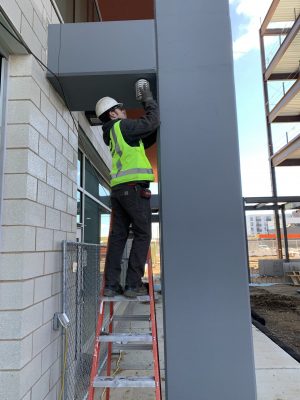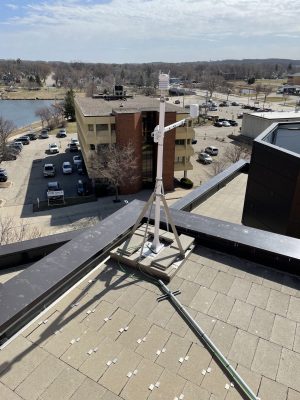
Healthy cities require healthy air. Thanks to a constellation of local organizations and civilian scientists, Rochester is poised to safeguard its air quality with robust data.
Destination Medical Center has partnered with University of Minnesota Rochester, Rochester Mayo Clinic, Olmsted County, the Sierra Club, We Bike Rochester, and civilian scientists to install a network of air quality sensors throughout the city.
The program started four years ago, thanks to then-University of Minnesota Rochester and Mayo Clinic School of Health Sciences student Matthew Spiten, now a respiratory therapist at Saint Marys Hospital. Passionate about the environment and respiratory health, he wanted a pathway for others to engage in cooperative environmental science.
In 2017, the program kicked off with a feasibility study. At the time, Olmsted County had just one air quality sensor, located atop Benjamin Franklin Elementary School in SE Rochester. Teams collected air quality samples at certain times of the day to measure changes.

“By and large, we have great air quality here in Rochester,” says Kevin Bright, Energy and Sustainability Director for the City of Rochester and Destination Medical Center.
But that quality needs to be kept up. Custom meter readings by participants showed higher particulate levels during morning and evening commute times. In large cities, that dynamic leads to bad air outweighing the benefits of exercise.
“We don’t want to wind up having people not being able to run during rush hour,” says Bright.
The program utilizes two kinds of sensors, PurpleAir and Vaisala, to detect particulate matter 2.5, tiny particles that can deposit into the lower lung and cause airway irritation, asthma exacerbations, respiratory illnesses like COPD exacerbations, cystic fibrosis, and complications for those with cardiopulmonary diseases.
The sensors have been strategically placed throughout the city using information from the Minnesota Pollution Control Agency. The study blends environmental and social justice by targeting neighborhoods identified as containing vulnerable populations.
“With these monitors in this new network, we’re going to be able to get a better picture of air quality throughout our community, and not just in one location,” says Spiten.

Measuring changes in air quality over time will give the city a predictive model built from data, making the question “What will make our community healthier?” a quantifiable one. Environmental and health dimensions can now enter discussions normally dominated by financial considerations.
Other cities have used air quality sensors to craft health-informed arguments for decisions: things like spending extra on an electric bus to ameliorate rush-hour drops in air quality or staggering transit schedules to avoid particulate congestion.
In Rochester, the data will help inform efforts to make downtown more walkable. The sensors will also measure the impact of the oxygen-providing urban forests planned along Discovery Walk and Heart of the City.
Anyone interested in helping is invited to get engaged through the community groups listed here. If households want to add to the data collection exercise locally, consider the purchase of a $250 air quality monitor and add it to the sensor network. For details, contact Kevin Bright at [email protected]